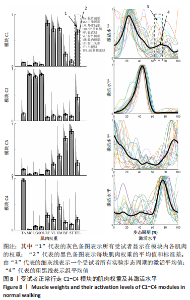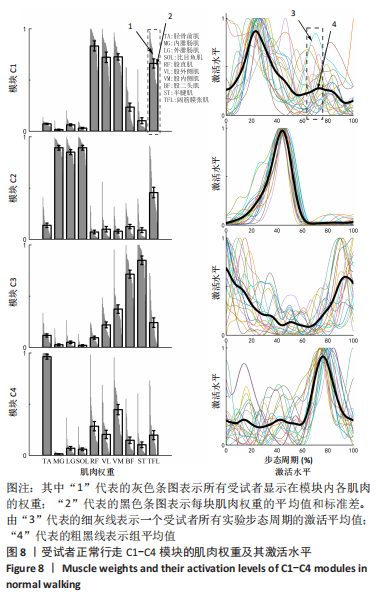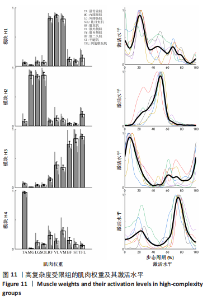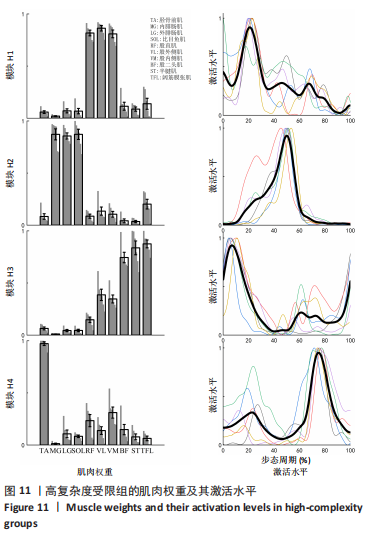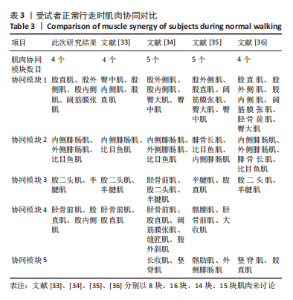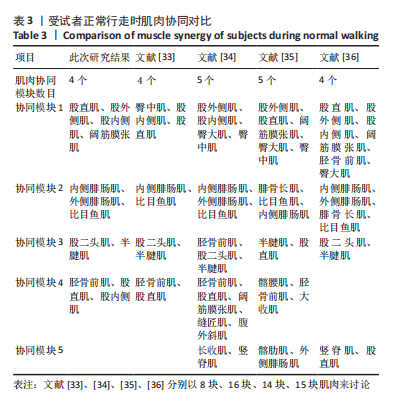Chinese Journal of Tissue Engineering Research ›› 2023, Vol. 27 ›› Issue (29): 4704-4711.doi: 10.12307/2023.658
Previous Articles Next Articles
Synergistic characteristics of lower extremity muscles with unilateral knee flexion limitation
An Yishuai1, 2, Zhang Junxia1, 2, Li Hui1, 2, Zhang Yuxiao1, 2, Xu Guoliang1, 2, Gao Kun1, 2, Yu Shuhan1, 2, Liu Zelong1, 2
- 1School of Mechanical Engineering, Tianjin University of Science & Technology, Tianjin 300222, China; 2Tianjin Key Laboratory of Integrated Design and Online Monitoring for Light Industry and Food Engineering Machinery and Equipment, Tianjin University of Science & Technology, Tianjin 300222, China
-
Received:2022-08-03Accepted:2022-09-07Online:2023-10-18Published:2022-12-02 -
Contact:Zhang Junxia, MD, Professor, School of Mechanical Engineering, Tianjin University of Science & Technology, Tianjin 300222, China; Tianjin Key Laboratory of Integrated Design and Online Monitoring for Light Industry and Food Engineering Machinery and Equipment, Tianjin University of Science & Technology, Tianjin 300222, China -
About author:An Yishuai, Master candidate, School of Mechanical Engineering, Tianjin University of Science & Technology, Tianjin 300222, China; Tianjin Key Laboratory of Integrated Design and Online Monitoring for Light Industry and Food Engineering Machinery and Equipment, Tianjin University of Science & Technology, Tianjin 300222, China -
Supported by:General Project of the National Natural Science Foundation of China, No. 50975204 (to ZJX)
CLC Number:
Cite this article
An Yishuai, Zhang Junxia, Li Hui, Zhang Yuxiao, Xu Guoliang, Gao Kun, Yu Shuhan, Liu Zelong. Synergistic characteristics of lower extremity muscles with unilateral knee flexion limitation[J]. Chinese Journal of Tissue Engineering Research, 2023, 27(29): 4704-4711.
share this article
Add to citation manager EndNote|Reference Manager|ProCite|BibTeX|RefWorks

2.1 参与者数量分析 试验纳入受试者20名,试验过程中无不良事件发生,全部进入结果分析。 2.2 正常行走肌肉协同分析 受试者通常以4个协同模块(55%)来自由行走,具体数目如图7所示。将所有受试者以4个模块进行肌肉协同提取,分别用模块C1、C2、C3和C4来表示,其中平均肌肉权重及其激活水平如图8所示。C1主要由膝关节伸肌(股外侧肌、股内侧肌和股直肌)和髋关节外展肌组成,这个模块从脚跟接触(步态周期的0%)到支撑末期(步态周期的50%)被激活,主要发挥吸收冲击、维持人体站立和稳定膝关节的作用;C2主要由踝关节足底屈肌(内侧腓肠肌、外侧腓肠肌和比目鱼肌)以及较小程度的阔筋膜张肌组成,并在推进阶段(步态周期的40%)被激活,该模块与蹬地时踝关节跖屈有关,有助于身体支撑、向前推进和摆动开始;C3由膝关节屈肌(股二头肌和半腱肌)组成,这种协同作用在摆动末期(步态周期的80%)和早期支撑阶段(步态周期的0%)被激活,该模块起到了在摆动结束时减慢腿的速度,并在早期支撑时推动身体的功能;C4主要包括踝关节背屈肌(胫骨前肌)和较小程度的髋屈肌、膝关节伸肌,它主要是在右脚离地的时候(步态周期的60%)开始被激活,起到了加速腿部摆动和提供背屈防止脚下垂的作用。"

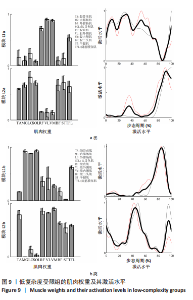
2.3 膝关节屈曲受限行走肌肉协同分析 相对于无受限行走,受试者受限后需要更少的肌肉协同数目行走,其中50%的受试者需要3个模块(图7)。由于运动输出复杂性取决于独立模块的数目[33],因此,试验将受限后拥有2、3和4个模块的受试者对应成低、中、高复杂度受限组。 2.3.1 低复杂度受限组肌肉协同分析 从低复杂度组中观察到两类不同的肌肉协同(a、b类)。a类中有一个模块具有明显的膝关节伸肌(股外侧肌、股内侧肌和股直肌)和髋关节外展肌表现,并在整个支撑阶段和摆动初末期活跃(Module-L1a);另一个模块由除了股外侧肌、股内侧肌和股直肌之外的所有测量肌肉表示,主要在摆动阶段活跃(Module- L2a)。在b类中观察到一个是以踝关节足底屈肌(内侧腓肠肌、外侧腓肠肌和比目鱼肌)以及较小程度的阔筋膜张肌主导,并在迈步阶段开始被激活的模块(Module-L1b);另一个模块以踝关节背屈肌(胫骨前肌)、膝关节伸肌(股外侧肌、股内侧肌和股直肌)、膝关节屈肌(股二头肌和半腱肌)和髋关节外展肌组成,主要在支撑期和摆动末期被激活(Module-L2b),见图9。"
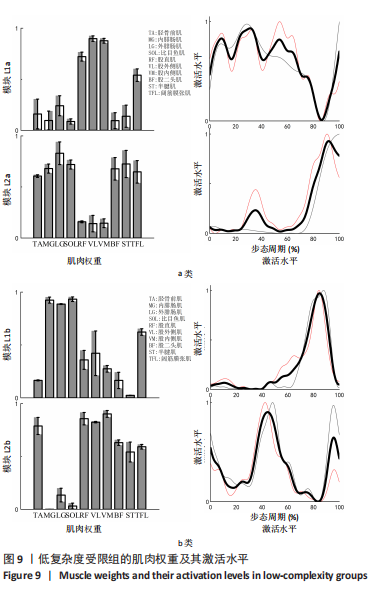
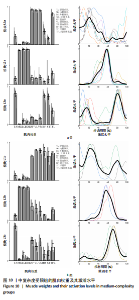
2.3.2 中复杂度受限组肌肉协同分析 在中复杂度组中,同样观察到2个通用类别的肌肉协同(a、b类)。10人中有7人具有明显的踝关节背屈肌(胫骨前肌)和膝关节屈肌(股二头肌)、半腱肌组成的模块(Module-M3a),该模块主要在摆动期和早期支撑阶段活跃,与腿部减速和预防足下垂有关,这类似于无受限组中观察到的模块C3和C4的组合;其余模块(Module-M1a和Module-M2a)分别类似于无受限组模块C1和C2,但肌肉权重较高于无受限组;在3个人中,观察到膝关节伸肌出现在与膝关节屈肌相同的模块中(Module-M1b),类似于无受限组中模块C1和C3的组合;其余模块(Module-M2b和Module-M3b)与无受限组中的模块C2和C4相似,见图10。值得注意的是,所有人都保持以胫骨前肌活动为主的独特摆动模块。"
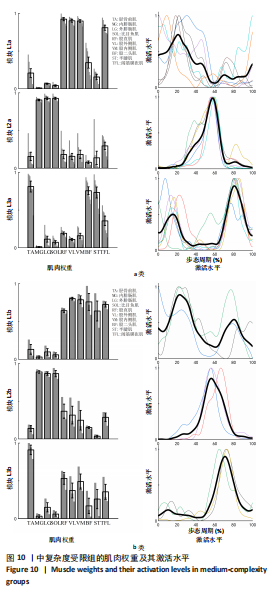
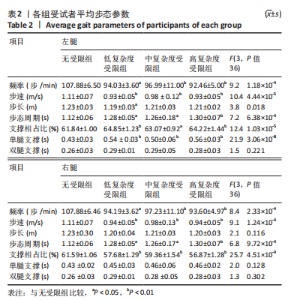
2.4 受试者步态参数分析 表2显示了无受限组和各个受限组的频率、步速、步长、步态周期、支撑相占比、单腿支撑时间和双腿支撑时间的平均值。受限后除了双腿支撑时间和受限侧(右腿)单腿支撑时间及其步长其余均有显著差异。在两两比较中,各受限组的非受限侧(左腿)在频率、步速、步态时间、支撑相占比和单腿支撑时间上均与无受限组有显著差异(P < 0.05),低复杂度组步长显著小于无受限组(P=0.02),而各受限组之间均无显著差异;各受限组的受限侧在频率、步速、步态时间和支撑相占比上均与无受限组有显著差异(P < 0.05),而且高复杂度受限组的支撑相占比显著小于中复杂度受限组(P=0.004),其余各受限组之间均无显著差异。受限侧与非受限侧各组内进行比较时,发现受限侧在支撑相占比上显著小于非受限侧(P < 0.001),而且受限侧在单腿支撑时间上显著小于非受限侧(P < 0.01)。"
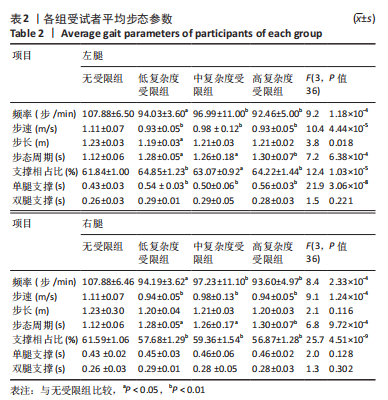
| [1] AFIAH IN, NAKASHIMA H, LOH PY, et al. An exploratory investigation of changes in gait parameters with age in elderly Japanese women. Springerplus. 2016;5(1):1069. [2] ZANIN M, OLIVARES F, PULIDO-VALDEOLIVAS I, et al. Gait analysis under the lens of statistical physics. Comput Struct Biotec. 2022;20:3257-3267. [3] ALLEN JL, KESAR TM, TING LH. Motor module generalization across balance and walking is impaired after stroke. J Neurophysiol. 2019; 122(1):277-289. [4] MILLER EL, MURRAY L, RICHARDS L, et al. Comprehensive overview of nursing and interdisciplinary rehabilitation care of the stroke patient: A scientific statement from the American Heart Association. Stroke. 2010;41(10):2402-2448. [5] LEWALLEN LK, SRIVASTAVA S, KAUTZ SA, et al. Assessment of turning performance and muscle coordination in individuals post-stroke. J Biomech. 2021;114:110113. [6] CAPPELLINI G, IVANENKO YP, POPPELE RE, et al. Motor patterns in human walking and running. J Neurophysiol. 2006;95(6):3426-3437. [7] TORRES-OVIEDO G, TING H. Muscle synergies characterizing human postural responses. J Neurophysiol. 2007;98(4):2144-2156. [8] NEPTUNE RR, CLARK DJ, KAUTZ SA. Modular control of human walking: A simulation study. J Biomech. 2009;42(9):1282-1287. [9] COSTA-GARCIA A, ITKONEN M, YAMASAKI H, et al. A novel approach to the segmentation of sEMG data based on the activation and deactivation of muscle synergies during movement. IEEE Robot Autom Let. 2018;3(3):1972-1977. [10] 辜禹,陈楠,刘倩,等.肌肉协同理论在小儿脑性瘫痪康复评定中的应用进展[J].中国康复理论与实践,2020,26(6):673-677. [11] IVANENKO YP, CAPPELLINI G, SOLOPOVA IA, et al. Plasticity and modular control of locomotor patterns in neurological disorders with motor deficits. Front Comput Neurosc. 2013;7(13):123. [12] SEAMON BA, NEPTUNE RR, KAUTZ SA. Using a module-based analysis framework for investigating muscle coordination during walking in individuals poststroke: A literature review and synthesis. Appl Bionics Biomech. 2018;2018:1-16. [13] 刘梦君,祁芳,曹倩茹,等.肌肉协同理论在脑性瘫痪儿童运动功能障碍分析中的应用与展望[J].湖南中医药大学学报,2022,42(5): 867-872. [14] 王洪安,佘青山,马玉良,等.卒中后上肢肌间协同耦合分析研究[J].传感技术学报,2020,33(10):1391-1398. [15] 李泽兵,楼惠军,孙玉春,等.膝关节僵直原因和治疗[J].上海医科大学学报,2000(3):231-232. [16] Handzic I, Reed KB. Comparison of the passive dynamics of walking on ground, tied-belt and split-belt treadmills, and via the Gait Enhancing Mobile Shoe (GEMS)[A]. 2013 IEEE 13th International Conference on Rehabilitation Robotics (ICORR). Seattle, WA: IEEE, 2013:1-6. [17] KERRIGAN DC, ROTH RS, RILEY PO. The modelling of adult spastic paretic stiff-legged gait swing period based on actual kinematic data. Gait Posture. 1998;7(2):117-124. [18] 江晓峰,胡雪艳.偏瘫步态膝关节角度分析[J].中国康复医学杂志, 2007,22(10):918-920. [19] 朱斌,梁勋.创伤后膝关节僵直原因分析及综合治疗120例报道[J].中国医药指南,2014,12(13):253-254. [20] DEN OTTER AR, GEURTS ACH, MULDER TH, et al. Abnormalities in the temporal patterning of lower extremity muscle activity in hemiparetic gait. Gait Posture. 2007;25(3):342-352. [21] LAMONTAGNE A, RICHARDS CL, MALOUIN F. Coactivation during gait as an adaptive behavior after stroke. J Electromyogr Kines. 2000;10(6): 407-415. [22] CELESTINO ML, VAN EMMERIK R, BARELA JA, et al. Effects of limited knee flexion movement in intra-limb gait coordination J Biomech. 2021;128:110712. [23] HUTIN E, PRADON D, BARBIER F, et al. Lower limb coordination patterns in hemiparetic gait: Factors of knee flexion impairment. Clin Biomech. 2011;26(3):304-311. [24] 张鹏,张峻霞.异构步道中下肢肌群不同时相的表面肌电特性[J].中国组织工程研究,2021,25(36):5814-5820. [25] MYERS LJ, LOWERY M, O’MALLEY M, et al. Rectification and non-linear pre-processing of EMG signals for cortico-muscular analysis. J Neurosci Meth. 2003;124(2):157-165. [26] CHEUNG VCK, TUROLLA A, AGOSTINI M, et al. Muscle synergy patterns as physiological markers of motor cortical damage. P Natl Acad Sci USA. 2012;109(36):14652-14656. [27] KIELIBA P, TROPEA P, PIRONDINI E, et al. How are muscle synergies affected by electromyography pre-processing? IEEE T Neur Sys Reh. 2018;26(4):882-893. [28] 杨毅,彭玉鑫,郝增明,等.复杂人体运动冗余控制的肌肉协同理论研究进展与展望[J].体育科学,2020,40(12):63-72. [29] LEE DD, SEUNG HS. Learning the parts of objects by non-negative matrix factorization. Nature. 1999;401(6755):788-791. [30] TRESCH MC, CHEUNG VCK, D’AVELLA A. Matrix factorization algorithms for the identification of muscle synergies: Evaluation on simulated and experimental data sets. J Neurophysiol. 2006;95(4):2199-2212. [31] TORRES-OVIEDO G, MACPHERSON JM, TING LH. Muscle synergy organization is robust across a variety of postural perturbations. J Neurophysiol. 2006;96(3):1530-1546. [32] FRÈRE J, HUG F. Between-subject variability of muscle synergies during a complex motor skill. Front Comput Neurosc. 2012;6:99. [33] CLARK DJ, TING LH, ZAJAC FE, et al. Merging of healthy motor modules predicts reduced locomotor performance and muscle coordination complexity post-stroke. J Neurophysiol. 2010;103(2):844-857. [34] KIBUSHI B, MORITANI T, KOUZAKI M. Modular control of muscle coordination patterns during various stride time and stride length combinations. Gait Posture. 2022;94:230-235. [35] ESMAEILI S, KARAMI H, BANIASAD M, et al. The association between motor modules and movement primitives of gait: A muscle and kinematic synergy study. J Biomech. 2022;134:110997. [36] CHIA BEJARANO N, PEDROCCHI A, NARDONE A, et al. Tuning of muscle synergies during walking along rectilinear and curvilinear trajectories in humans. Ann Biomed Eng. 2017;45(5):1204-1218. [37] RANDSBORG PH, TAJET J, NEGÅRD H, et al. Manipulation under anesthesia for stiffness of the knee joint after total knee replacement. Arthroplasty Today. 2020;6(3):470-474. [38] BENSOUSSAN L, MESURE S, VITON JM, et al. Kinematic and kinetic asymmetries in hemiplegic patients’ gait initiation patterns. J Rehabil Med. 2006;38(5):287-294. [39] BALASUBRAMANIAN CK, BOWDEN MG, NEPTUNE RR, et al. Relationship between step length asymmetry and walking performance in subjects with chronic hemiparesis. Arch Phys Med Rehab. 2007; 88(1):43-49. [40] ALLEN JL, KAUTZ SA, NEPTUNE RR. Step length asymmetry is representative of compensatory mechanisms used in post-stroke hemiparetic walking. Gait Posture. 2011;33(4):538-543. [41] LIU C, FINLEY JM. Asymmetric gait patterns alter the reactive control of intersegmental coordination patterns in the sagittal plane during walking. PLoS One. 2020;15(5):e0224187. [42] MONACO V, GHIONZOLI A, MICERA S. Age-related modifications of muscle synergies and spinal cord activity during locomotion. J Neurophysiol. 2010;104(4):2092-2102. |
| [1] | Bi Gengchao, Zhang Yanlong, Li Qiuyue, Hu Longwei, Zhang Yu. Knee joint mechanics and activation characteristics of surrounding muscles during deep jumps at different heights and distances [J]. Chinese Journal of Tissue Engineering Research, 2023, 27(8): 1211-1218. |
| [2] | Xiong Bohan, Yu Yang, Lu Xiaojun, Wang Xu, Yang Tengyun, Zhang Yaozhang, Liao Xinyu, Zhou Xiaoxiang, He Lu, Li Yanlin. Research progress in promoting tendon to bone healing during anterior cruciate ligament reconstruction [J]. Chinese Journal of Tissue Engineering Research, 2023, 27(5): 779-786. |
| [3] | Wei Bo, Yao Qingqiang, Tang Cheng, Li Xuxiang, Xu Yan, Wang Liming. Advantage of medial pivot prosthesis in total knee arthroplasty via medial subvastus approach [J]. Chinese Journal of Tissue Engineering Research, 2023, 27(4): 552-557. |
| [4] | Li Shihao, Li Qi, Li Zhen, Zhang Yuanyuan, Liu Miaomiao, Ouyang Yi, Xu Weiguo. Plantar pressure and gait analysis in patients with anterior cruciate ligament injury and reconstruction [J]. Chinese Journal of Tissue Engineering Research, 2023, 27(4): 626-631. |
| [5] | Chen Changmei, Zeng Xianchun, Wang Rongpin, Wu Jiahong. Sex and age differences in the anatomical parameters of normal knee joints evaluated by X-ray [J]. Chinese Journal of Tissue Engineering Research, 2023, 27(29): 4647-4651. |
| [6] | Li Panpan, Qing Haomiao, Ren Sixie, Zhang Yuanyuan. Correlation of medial and lateral posterior tibial slope and their differences with anterior cruciate ligament injury [J]. Chinese Journal of Tissue Engineering Research, 2023, 27(27): 4379-4384. |
| [7] | Wang Jiawei, Liu Ye. Hip and knee coordination patterns in relation to lower limb muscle activity during drop jumps at different heights [J]. Chinese Journal of Tissue Engineering Research, 2023, 27(2): 276-281. |
| [8] | Zhang Xiaohui, Zhang Mingjun, Wang Jianping, Qu Haijun, Chai Le, Li Yu, Zhang Xinmin. Constructing digital model of knee joint and surrounding soft tissue surface by three-dimensional image registration technology [J]. Chinese Journal of Tissue Engineering Research, 2023, 27(18): 2814-2819. |
| [9] | Xu Zhi, Li Yuwan, Jin Ying, Liu Yi. Effect of partial posterior root tear of medial meniscus on biomechanics of the knee joint during gait cycle [J]. Chinese Journal of Tissue Engineering Research, 2023, 27(18): 2824-2830. |
| [10] | Fang Run, Ning Rende, Liu Yulong, Bi Chenghao, Zhou Daobin. Significance of X-ray measurement of the anatomical relationship between adult lateral tibial plateau and lateral femoral condyle in fracture reduction [J]. Chinese Journal of Tissue Engineering Research, 2023, 27(13): 2076-2080. |
| [11] | Wang Jianping, Zhang Xiaohui, Yu Jinwei, Wei Shaoliang, Zhang Xinmin, Xu Xingxin, Qu Haijun. Application of knee joint motion analysis in machanism based on three-dimensional image registration and coordinate transformation [J]. Chinese Journal of Tissue Engineering Research, 2022, 26(在线): 1-5. |
| [12] | Wang Shuai, Wang Liancheng, Zhang Shuhao, Li Fuli, Dong Jiaxing, Zhang Yajie. Correlation of the electromyography ratio of the paraspinal muscles on the convex and concave sides with Cobb angle, apical vertebra translation, and coronal balance distance in adolescent idiopathic scoliosis patients [J]. Chinese Journal of Tissue Engineering Research, 2022, 26(9): 1402-1406. |
| [13] | Wu Bingshuang, Wang Zhi, Tang Yi, Tang Xiaoyu, Li Qi. Anterior cruciate ligament reconstruction: from enthesis to tendon-to-bone healing [J]. Chinese Journal of Tissue Engineering Research, 2022, 26(8): 1293-1298. |
| [14] | Shao Yangyang, Zhang Junxia, Jiang Meijiao, Liu Zelong, Gao Kun, Yu Shuhan. Kinematics characteristics of lower limb joints of young men running wearing knee pads [J]. Chinese Journal of Tissue Engineering Research, 2022, 26(6): 832-837. |
| [15] | Zhou Jianguo, Liu Shiwei, Yuan Changhong, Bi Shengrong, Yang Guoping, Hu Weiquan, Liu Hui, Qian Rui. Total knee arthroplasty with posterior cruciate ligament retaining prosthesis in the treatment of knee osteoarthritis with knee valgus deformity [J]. Chinese Journal of Tissue Engineering Research, 2022, 26(6): 892-897. |
| Viewed | ||||||
|
Full text |
|
|||||
|
Abstract |
|
|||||
